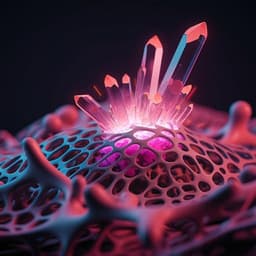
Engineering and Technology
Leaf-meridian bio-inspired nanofibrous electronics with uniform distributed microgrid and 3D multi-level structure for wearable applications
M. Wang, L. Dong, et al.
This research presents an innovative bio-inspired nanofibrous membrane designed for wearable electronics. By emulating frond leaves, the team has developed a pressure sensor with remarkable sensitivity, quick response times, and a low detection threshold, paving the way for next-generation wearable devices. This work was conducted by Mingxu Wang, Li Dong, Jiajia Wu, Jian Shi, Qiang Gao, Chunhong Zhu, and Hideaki Morikawa.
~3 min • Beginner • English
Introduction
The study addresses the challenge of tuning and preserving the interface properties between active electronics and their targets to achieve highly sensitive, comfortable, and multifunctional wearable sensors. Traditional flexible sensor materials (e.g., gels, PDMS-based elastomers, Ecoflex composites) achieve flexibility and electroactivity but often lack breathability, moisture permeability, lightness, and skin-friendliness, and typically provide only single-function capability. Electrospun nanofibers offer a promising platform due to high surface area, tunable fiber diameters, mechanical compliance, and biocompatibility, making them suitable for direct tissue interfaces. A key performance parameter for pressure sensors is high sensitivity with wide, linear operating ranges. Inspired by natural microstructures (e.g., pyramids, cylinders, hemispheres, hierarchical surfaces), microstructuring can enhance compressibility, reduce viscoelastic hysteresis, and speed response. However, nanofibrous-membrane sensors have largely focused on single-fiber surface modifications, facing issues of substrate selectivity, cost, processing complexity, and durability. This work proposes a universal, simple, and cost-effective structural strategy—bioinspired from frond leaf meridians—to create a multi-level, uniformly distributed grid-like nanofibrous membrane that enhances pressure sensing and enables multifunctional wearable applications.
Literature Review
Prior work in wearable and flexible electronics highlights advances in soft sensors for health monitoring, human–machine interfaces, and robotics using gels, PDMS-based conductive elastomers, and Ecoflex composites, but with limitations in comfort and multifunctionality. Electrospinning enables large-scale, tunable nanofiber production with diverse morphologies and biocompatibility, supporting soft, breathable, and lightweight devices. To improve sensor sensitivity and linearity, bioinspired microstructures (pyramids, cylinders, hemispheres, hierarchical patterns) have been introduced to enhance compressibility and reduce hysteresis, yielding faster responses. Examples include carbonized silk fabric with CNTs for airflow sensing, abrasive paper-templated spinosum microstructures for higher sensitivity and range, and folding structures to extend range across resistive, capacitive, and inductive sensors. Yet, structural strategies specifically for nanofibrous membranes remain scarce, with most efforts on nanoscale surface roughness via nanowires/sheets/particles, often incurring poor substrate selectivity, high cost, technical difficulty, and reduced service life. This motivates a new, scalable structural design approach for nanofiber-based sensors.
Methodology
Materials: PU (Mw ~110,000), CCNTs (length 5–10 µm, diameter 10–30 nm), EDOT, DMF, THF, FeCl3, citric acid (CA), ethanol, and cyclohexane were used as received.
Fabrication of matrix with hierarchical grid-like structure (PCN):
- Prepare spinning dope: 1.6 g PU + CCNTs (1 wt% relative to PU) + 0.32 g CA dissolved in 8.4 mL DMF/THF (1:1 by mass) to 16 wt% solids; stir 12 h at 65 °C to homogenize.
- Electrospinning: voltage 13.5 kV, flow rate 1.5 mL h−1, tip-to-collector distance 15 cm. A metal mesh serves as the collector to imprint a uniformly distributed grid-like microstructure and multi-level layered architecture.
- Drying: 50 °C for 5 h to remove residual solvents. The resulting PU/CCNTs membrane is denoted PCN.
Surface activation and in situ PEDOT polymerization (PPCN):
- Plasma treatment: 30 W, 150 s to increase hydrophilicity (contact angle change from superhydrophobic to ~75° after CCNT/CA incorporation and plasma).
- Ion adsorption: immerse in FeCl3 ethanol solution (0.01 M) for 5 min; dry at 70 °C for 3 min to yield PCN–Fe3+ (uniform Fe/Cl distribution confirmed by EDS/XRD).
- Polymerization: soak in EDOT monomer (cyclohexane, 0.08 M) at room temperature to grow PEDOT on fiber surfaces; wash with ethanol and dry at 30 °C to obtain PPCN. Polymerization time varied (2–36 h); 18 h optimized for conductivity (~26.3 S cm−1) without over-damaging structure.
CCNT anchoring by ultrasonication (TPPCN):
- Immerse PPCN in CCNT dispersion (ethanol, 1.5 mg L−1) and ultrasonicate for 45 min to anchor entangled CCNTs onto PEDOT-coated fibers; rinse with ethanol and dry at 60 °C for 5 h to obtain CCNTs/PEDOT@PCN (TPPCN). CCNT coverage increases with sonication time; 45 min chosen for uniform coverage without structural damage.
- Control sample: TPPCN-blank prepared identically but electrospun on Al foil (no grid-like structure) for comparison.
Characterization:
- Morphology/structure: SEM (fiber diameter, porosity, cross-sections), 3D profilometry of grid microstructure (~50 µm center height), TEM (core–shell PEDOT on fibers, CCNT anchoring), EDS mapping/XPS (S, Fe, Cl, C, O distribution), FT-IR (PU urethane bands; PEDOT signatures at 1533, 1358, 1215, 980, 834, 690 cm−1).
- Wetting: contact angle measurements (hydrophobic to hydrophilic transition post plasma/CA).
- Mechanical: tensile stress–strain tests (PU vs PCN vs PPCN vs TPPCN), noting rigidity increase with CCNTs and moderate strength reduction after polymerization/sonication.
- Electrical: conductivity vs polymerization time (2–36 h); PPCN stability in acid (pH 2), alkali (pH 12), 0.1 M NaCl, and ethanol (>6 h); I–V characteristics under pressure.
- Pressure sensing: assemble TPPCN between electrodes; measure relative resistance change vs pressure (0–8 kPa), response/recovery times, detection limit, frequency response (0.5–1 Hz), stability over 1000 cycles, and spatial arrays on fabrics/gloves for mapping. Gauge factor S defined as GF = (R0 − R)/(R × ΔP).
- Modeling/simulation: finite-element analysis of surface pressure/stress distribution for pyramid, hemisphere, cylinder, and grid-like morphologies under 5 kPa to evaluate stress concentration and homogeneity; equivalent circuit model for multi-layer contact (RL and Rc, with Rc decreasing and contact junction number n changing with pressure).
Device demonstrations:
- Tactile sensor arrays: TPPCN units woven/laminated onto textiles, integrated with Cu wiring and PDMS encapsulation; 2×2 and 4×4 arrays for touch localization and pressure mapping; demonstration of fabric piano and Morse code via waveform control.
- Wearable heater/temperature sensor: apply DC bias (0.5–2 V) to TPPCN; monitor temperature rise/time and IR thermal images at various setpoints; thermochromic PDMS encapsulation for visual current/heat indication; cyclic heating 33–50 °C; simultaneous resistance–temperature measurements for thermosensitivity (20–100 °C) and responses to hot/ice water proximity.
- Triboelectric nanogenerator (TENG): sandwich structure with CCNT-doped PDMS as tribolayer and TPPCN as electrode; contact–separation with Al foil; measure output voltage/current vs applied force (up to 2 N) and frequency (0.5–4 Hz); rectify to power LEDs.
Key Findings
- Bioinspired multi-level nanofibrous membrane (TPPCN) with uniformly distributed grid-like microstructure was successfully fabricated by coupling electrospinning on a metal mesh, in situ PEDOT polymerization, and ultrasonic CCNT anchoring.
- Morphology: Regular grid microstructure uniformly distributed with ~50 µm center height; multi-level layered architecture preserved; PEDOT forms a core–shell coating; CCNTs entangle and wrap the fiber surface creating roughness.
- Fiber metrics: Average diameter reduced from ~0.76 µm (PU) to ~0.53 µm (PCN), increased to ~0.64 µm (PCN–Fe3+), and ~0.77 µm (PPCN at 18 h); porosity inversely related to diameter; polymerization significantly reduces porosity.
- Conductivity: Non-conductive PU; PCN ~10^9 Ω (beyond multimeter); PPCN reaches ~0.5 S cm−1 after 2 h polymerization and ~26.3 S cm−1 at 18 h; stable in acidic/alkaline/saline/ethanol environments (>6 h). CCNT anchoring does not further raise bulk conductivity but enhances surface roughness/contact behavior.
- Mechanical: Rigidity increases with CCNTs; some strength reduction after prolonged solvent/polymerization and ultrasonication (e.g., TPPCN strength ~0.92 MPa; PPCN 1.21 MPa); elongation largely maintained.
- Pressure sensing performance (TPPCN):
• Sensitivity (GF): 5.13 kPa−1 (0–1.0 kPa) and 0.41 kPa−1 (1.0–8.0 kPa).
• Detection limit: ~1 Pa with repeatable signals.
• Response/recovery: ~80 ms / ~120 ms.
• Stability: Reversible signals over 1000 loading/unloading cycles (0–500 Pa) and consistent responses across 0.5–1 Hz at 0.25–5 kPa.
• Structured vs blank: Grid/multi-level structure yields ~200% higher initial GF and shorter response times; blank sample shows ~100% decline in sensitivity (~2.46 kPa−1) and slower dynamics.
- Mechanism: Increasing pressure enhances interlayer contact junctions, reducing Rc in the equivalent circuit; grid morphology yields more homogeneous stress distribution than pyramid/hemisphere/cylinder, enabling fast low-pressure response and extended linearity via additional contact formation at higher pressures; CCNT-induced roughness improves low-stress detection and response speed.
- Tactile sensing demos: Textile-integrated arrays (2×2, 4×4) enable touch localization, configurable waveforms (sine/Arb/half-sine/square), Morse code signaling, and pressure mapping of placed objects; glove-integrated sensors capture grasping force and impact distributions; human motion/physiology monitoring (finger/elbow bending, cheek blow, head nod, jumping, pulse) shows repeatable, distinct signal patterns.
- Electric-thermal performance: Rapid Joule heating with low voltage; at 2 V, ~70 °C in ~60 s; IR imaging up to 100 °C (5 V). Stable cyclic heating between 33–50 °C over multiple cycles. Thermosensitivity: resistance decreases with temperature; sensitivity ~3.41% °C−1 (20–85 °C) and ~16.6% °C−1 (85–100 °C); clear responses to proximity of hot (75 °C) and ice (20 °C) water.
- Energy harvesting (TENG): 40×40 mm device outputs ~78 V open-circuit and ~0.45 µA short-circuit at 2 N; voltage increases with pressure and frequency (0.5–4 Hz). Rectified output lights LEDs, demonstrating self-powered capability.
Discussion
The research demonstrates that engineering the interfacial architecture of nanofibrous membranes with a bioinspired, uniformly distributed grid and spatial multi-level layering significantly enhances pressure sensing performance while preserving flexibility and enabling integration. The equivalent circuit model shows that applied pressure primarily reduces contact resistance by increasing and tightening interlayer contact junctions; the effect is strongest at low pressures, leading to high sensitivity and fast response. Finite-element simulations confirm that the grid microstructure provides more homogeneous stress distribution compared to pyramid/hemisphere/cylinder surfaces, allowing efficient load transfer from protrusion tips to roots, facilitating small-deformation responsiveness at low pressures and providing additional contact formation at higher loads for extended linearity. CCNT-induced nanoscale roughness further stabilizes contact under very low stress, improving detection limits and dynamics. These mechanisms collectively address the challenge of achieving both high sensitivity and wide linear range in nanofiber-based resistive pressure sensors. Beyond sensing, the high conductivity and processability enable multifunctional devices—wearable heaters/temperature sensors and TENGs—underscoring the platform’s relevance for integrated wearable systems and human–machine interfaces.
Conclusion
A universal and cost-effective fabrication strategy combining electrospinning on a metal mesh, in situ PEDOT polymerization, and ultrasonic CCNT anchoring yielded a bioinspired TPPCN nanofibrous membrane with a uniform grid-like, multi-level structure. The membrane enables a high-performance pressure sensor with ultralow detection limit (~1 Pa), fast response/recovery (~80/120 ms), and high sensitivities (5.13 and 0.41 kPa−1 across 0–1.0 and 1.0–8.0 kPa). The same platform supports tactile arrays for spatial force mapping and human motion monitoring, efficient low-voltage Joule heating with thermosensing capability, and a triboelectric nanogenerator that powers LEDs. These contributions provide a scalable route to multifunctional, comfortable, and integrable e-textiles for next-generation wearable electronics and human–machine interfaces.
Limitations
- Mechanical trade-offs: Repeated solvent exposure, prolonged in situ polymerization, and ultrasonication slightly reduce mechanical strength and can damage the nanofibrous structure; PPCN becomes fragile when polymerization exceeds ~36 h.
- Porosity reduction: PEDOT polymerization increases fiber diameter and reduces membrane porosity, which may impact airflow/breathability (not quantitatively analyzed).
- Conductivity plateau: PEDOT layer dominates conductivity; subsequent CCNT anchoring does not further increase bulk conductivity (added primarily for interfacial roughness and sensing enhancement).
- Testing scope: Long-term environmental stability beyond 1000 mechanical cycles and >6 h chemical exposures was not reported; broader durability/lifespan studies are needed for real-world use.
Related Publications
Explore these studies to deepen your understanding of the subject.







